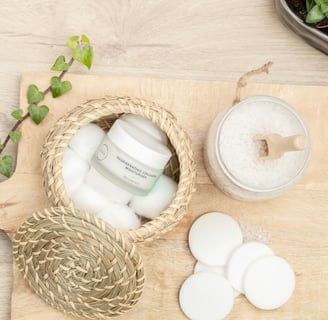Why Grass-Fed Tallow is the Ultimate Superfood for Your Skin


Why Grass-Fed Tallow is the Ultimate Superfood for Your Skin
If you haven't yet hopped on the tallow skincare train, let me just say: you're missing out. There's a reason why our ancestors slathered animal fats on their skin long before beauty aisles were packed with chemical cocktails in plastic bottles. Among all the natural skincare ingredients making a comeback, grass-fed beef tallow stands out as a true hero—a skin superfood, if you will.
In this post, we're diving deep into what makes grass-fed tallow so good for your skin, why it's making waves in the clean beauty community, and how you can incorporate it into your daily skincare ritual. And don’t worry—we’re keeping things real, relatable, and rooted in science.
What Is Grass-Fed Tallow, Exactly?
Tallow is rendered fat, typically from beef or mutton, but for skincare, beef tallow is the gold standard. Now, not all tallow is created equal. Grass-fed tallow comes from cattle that have grazed on pasture their entire lives, rather than being grain-fed in feedlots. Why does that matter? Because the nutrient profile of grass-fed beef fat is vastly superior. More vitamins, more antioxidants, more skin-loving compounds.
Think of grass-fed tallow as the clarified butter of the skincare world: pure, rich, and deeply nourishing.
Why Tallow Is a Skin Superfood
Let’s break it down. What exactly makes grass-fed tallow such a powerhouse?
Fatty Acid Profile That Mimics Human Skin
Our skin's sebum (natural oil) has a unique composition, and guess what? Tallow is strikingly similar. It’s loaded with oleic acid, palmitic acid, and stearic acid—the very lipids our skin craves for repair and hydration. That means tallow sinks in beautifully and doesn’t just sit on top of your skin like a greasy film.Rich in Fat-Soluble Vitamins
Grass-fed tallow is packed with vitamins A, D, E, and K. These are crucial for skin regeneration, anti-aging, and maintaining elasticity.Vitamin A supports cell turnover and helps smooth out texture.
Vitamin D is anti-inflammatory and supports the skin barrier.
Vitamin E is a powerful antioxidant that helps protect against free radicals.
Vitamin K supports wound healing and can help with dark circles and redness.
Anti-Inflammatory and Healing Properties
If you deal with eczema, psoriasis, acne, or rosacea, tallow might be your new best friend. Its naturally occurring anti-inflammatory compounds help calm irritation, soothe redness, and support the healing process.Non-Comedogenic (Yep, Really)
Despite being an animal fat, tallow won’t clog your pores. Its compatibility with our skin means it nourishes without suffocating, unlike synthetic moisturizers or even some plant oils.
The Grass-Fed Difference
Why not just use regular tallow? Or coconut oil? Or shea butter?
Grass-fed tallow is not just about the fat—it’s about what’s in the fat. Grass-fed cattle produce fat that’s higher in:
Conjugated Linoleic Acid (CLA): A fatty acid known for its anti-inflammatory and antimicrobial properties.
Omega-3 Fatty Acids: Vital for reducing inflammation and supporting the skin barrier.
Beta-Carotene: The antioxidant that gives grass-fed fat its yellow tint and helps protect skin from oxidative stress.
It’s like nature made this stuff for your face.
But Wait... Is It Weird to Use Animal Fat on Your Skin?
Totally fair question. If you’re new to the idea, it might sound a little "Little House on the Prairie," but stay with me.
First off, humans have used animal fats for skin protection for centuries. Indigenous cultures, pioneers, and even your great-grandparents probably used some version of it. It’s only in recent decades that we’ve moved toward lab-made ingredients with names you can’t pronounce.
Second, tallow is sustainable, especially when it's a byproduct of ethically raised animals. Instead of letting this nutrient-rich fat go to waste, we’re putting it to excellent use.
So no, it’s not weird. It’s old-school wisdom meeting modern clean beauty.
Benefits You Might Notice (Quickly)
People who switch to tallow-based skincare often report noticeable results in a matter of days:
Softer, smoother skin
Less redness and irritation
More even skin tone
Dry patches disappearing
A dewy, healthy glow without feeling oily
It’s especially a game-changer during winter months or if you live in a dry climate.
How to Use It
A little goes a long way. Here are some easy ways to incorporate grass-fed tallow into your routine:
Moisturizer: After cleansing, apply a pea-sized amount to damp skin. It locks in moisture and absorbs quickly.
Night Cream: Tallow is perfect for overnight repair. Blend with calming essential oils like lavender or chamomile for extra relaxation.
Lip Balm: Tallow is amazing for chapped lips—far better than petroleum-based balms.
Baby Balm: Safe enough for baby’s sensitive skin.
After-Sun Care: Its soothing properties help heal and hydrate sun-exposed skin.
You can also find whipped tallow balms that are blended with other nourishing oils like jojoba, emu, or rosehip for added benefits.
DIY or Buy?
If you’re the hands-on type, rendering your own tallow at home can be satisfying (and thrifty). But for those of us who prefer convenience, there are some fantastic tallow-based products on the market. Look for ones that are:
100% grass-fed and grass-finished
Free of synthetic fragrances and preservatives
Packaged in glass or other non-toxic containers
Bonus points if the brand supports regenerative farming practices.
Who Should Avoid It?
Tallow is generally well-tolerated, even by those with sensitive skin. However, if you're strictly vegan, tallow isn't for you.
If you have allergies to beef products (rare, but possible), do a patch test first. Always know your ingredients.
Final Thoughts
In a world where skincare routines are getting more complicated and expensive, tallow offers a refreshingly simple, effective solution. It’s nutrient-dense, time-tested, and biologically compatible with your skin.
Grass-fed tallow isn’t just a trend. It’s a return to what works.
So whether you're battling chronic dryness, dealing with sensitive skin, or just trying to cut down on synthetic junk, give grass-fed tallow a try. Your skin will thank you—and honestly, so will your wallet.
Nature knows best. Sometimes, the simplest answer really is the most powerful.